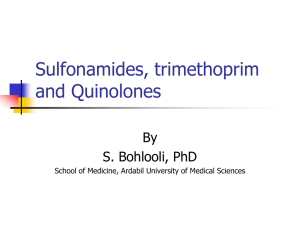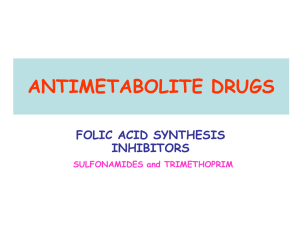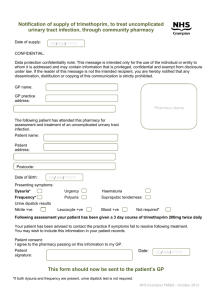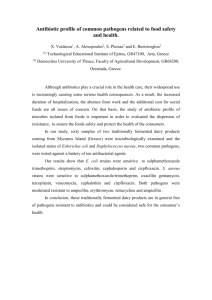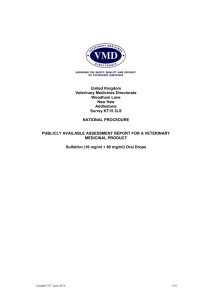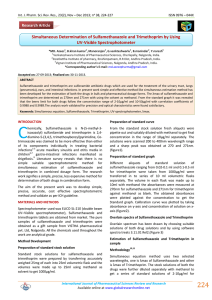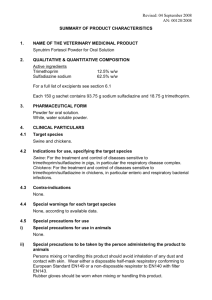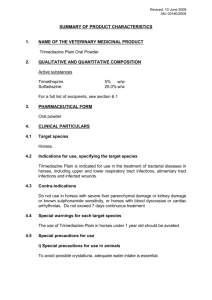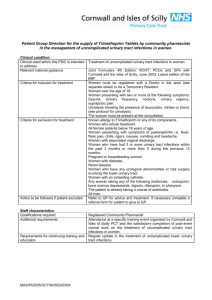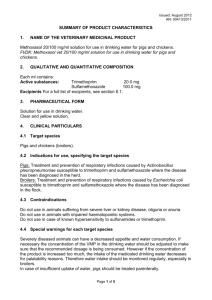Overview of the Folate Antagonists
advertisement
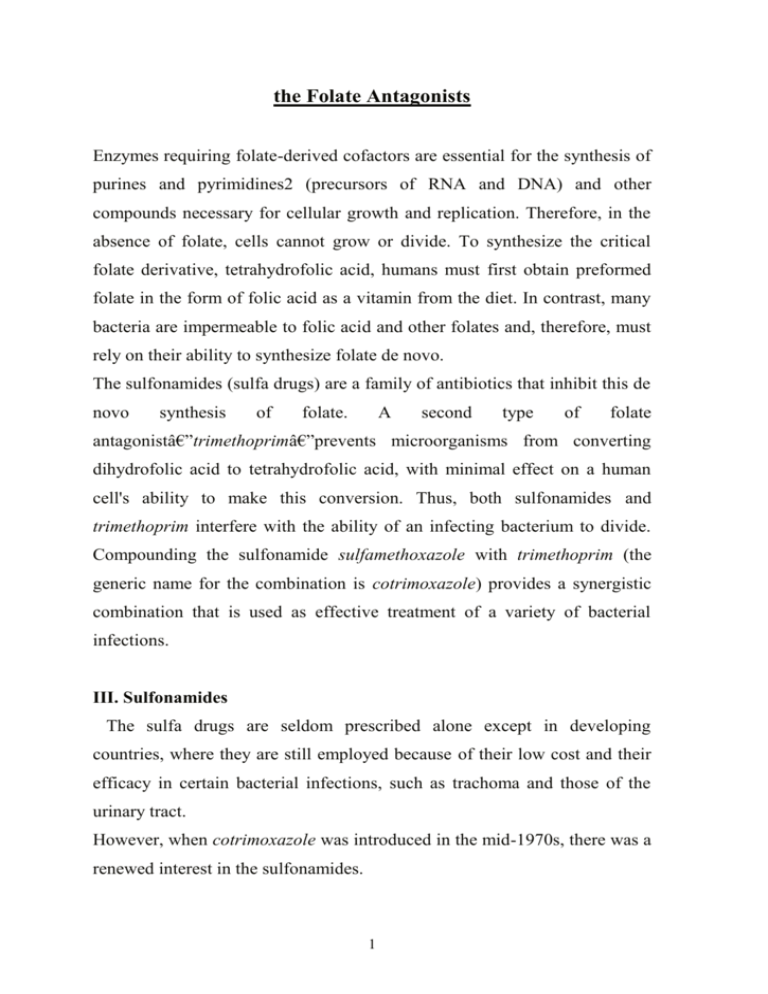
the Folate Antagonists Enzymes requiring folate-derived cofactors are essential for the synthesis of purines and pyrimidines2 (precursors of RNA and DNA) and other compounds necessary for cellular growth and replication. Therefore, in the absence of folate, cells cannot grow or divide. To synthesize the critical folate derivative, tetrahydrofolic acid, humans must first obtain preformed folate in the form of folic acid as a vitamin from the diet. In contrast, many bacteria are impermeable to folic acid and other folates and, therefore, must rely on their ability to synthesize folate de novo. The sulfonamides (sulfa drugs) are a family of antibiotics that inhibit this de novo synthesis of folate. A second type of folate antagonist—trimethoprim—prevents microorganisms from converting dihydrofolic acid to tetrahydrofolic acid, with minimal effect on a human cell's ability to make this conversion. Thus, both sulfonamides and trimethoprim interfere with the ability of an infecting bacterium to divide. Compounding the sulfonamide sulfamethoxazole with trimethoprim (the generic name for the combination is cotrimoxazole) provides a synergistic combination that is used as effective treatment of a variety of bacterial infections. III. Sulfonamides The sulfa drugs are seldom prescribed alone except in developing countries, where they are still employed because of their low cost and their efficacy in certain bacterial infections, such as trachoma and those of the urinary tract. However, when cotrimoxazole was introduced in the mid-1970s, there was a renewed interest in the sulfonamides. 1 Sulfa drugs differ from each other not only in their chemical and physical properties but also in their pharmacokinetics. A. Mechanism of action In many microorganisms, dihydrofolic acid is synthesized from paminobenzoic acid (PABA), pteridine, and glutamate . All the sulfonamides currently in clinical use are synthetic analogs of PABA.3 Because of their structural similarity to PABA, the sulfonamides compete with this substrate for the bacterial enzyme, dihydropteroate synthetase. They thus inhibit the synthesis of bacterial dihydrofolic acid and, thereby, the formation of its essential cofactor forms.4 The sulfa drugs, including cotrimoxazole, are bacteriostatic. B. Antibacterial spectrum Sulfa drugs are active against selected enterobacteria in the urinary tract and nocardia. In addition, sulfadiazine [sul-fa-DYE-a-zeen], in combination with the dihydrofolate reductase inhibitor pyrimethamine [py-ri-METH-ameen], is the preferred form of treatment for toxoplasmosis and chloroquineresistant malaria. C. Resistance Only organisms that synthesize their folate requirements de novo are sensitive to the sulfonamides. Thus, humans, who synthesize critical folate cofactors from dietary folic acid, are not affected, and bacteria that can obtain folates from their environment are naturally resistant to these drugs. Acquired bacterial resistance to the sulfa drugs can arise from plasmid transfers or random mutations. [Note: Organisms resistant to one member of this drug family are resistant to all.] Resistance is generally irreversible and may be due to 1) an altered dihydropteroate synthetase, 2)decreased cellular permeability to sulfa drugs, or 3) enhanced production of the natural substrate, PABA. 2 D. Pharmacokinetics 1.Administration: After oral administration, most sulfa drugs are well absorbed via the small intestine . An exception is sulfasalazine [sul-fa-SALa-zeen]. It is not absorbed when administered orally or as a suppository and, therefore, is reserved for treatment of chronic inflammatory bowel disease (for example, Crohn's disease or ulcerative colitis). [Note: Local intestinal flora split sulfasalazine into sulfapyridine and 5-aminosalicylate, with the latter exerting the anti-inflammatory effect. Absorption of the sulfapyridine can lead to toxicity in patients who are slow acetylators. Intravenous sulfonamides are generally reserved for patients who are unable to take oral preparations. Because of the risk of sensitization, sulfas are not usually applied topically. However, in burn units, creams of silver sulfadiazine or mafenide [mah-FEN-ide] acetate (α-amino-p-toluene-sulfonamide) have been effective in reducing burn-associated sepsis, because they prevent colonization of bacteria. Superinfections with resistant bacteria or fungi may still occur. 2.Distribution: Sulfa drugs are bound to serum albumin in the circulation, where the extent of binding depends on the particular agent's pKa. In general, the lower the pKa, the greater the binding. Sulfa drugs distribute throughout the body's water and penetrate well into cerebrospinal fluid—even in the absence of inflammation. They can also pass the placental barrier and enter fetal tissues. 3.Metabolism: The sulfa drugs are acetylated, primarily in the liver. The product is devoid of antimicrobial activity 3 but retains the toxic potential to precipitate at neutral or acidic pH. This causes crystalluria (â€oestone formation†; see below) and, therefore, potential damage to the kidney. 4. Excretion: Sulfa drugs are eliminated by glomerular filtration. Therefore, depressed kidney function causes accumulation of both the parent compounds and their metabolites. The sulfonamides may also be eliminated in breast milk. E Adverse effects 1.Crystalluria: Nephrotoxicity develops as a result of crystalluria Adequate hydration and alkalinization of urine prevent the problem by reducing the concentration of drug and promoting its ionization. Agents, such as sulfisoxazole [sul-fi-SOX-a-zole] and sulfamethoxazole [sul-fa-meth-OX-azole] are more soluble at urinary pH than are the older sulfonamides (for example, sulfadiazine) and are less liable to cause crystalluria . 2.Hypersensitivity: Hypersensitivity reactions, such as rashes, angioedema, and Stevens-Johnson syndrome, are fairly common. The latter occurs more frequently with the longer-acting agents. 3.Hemopoietic disturbances: Hemolytic anemia is encountered in patients with glucose 6-phosphate dehydrogenase deficiency.Granulocytopenia and thrombocytopenia can also occur. 4.Kernicterus: This disorder may occur in newborns, because sulfa drugs displace bilirubin from binding sites on serum albumin. The bilirubin is then free to pass into the CNS, because the baby's blood-brain barrier is not fully Developed. 5.Drug potentiation: Transient potentiation of the hypoglycemic effect of tolbutamide or the anticoagulant effect of warfarin results from their displacement from binding sites on serum albumin. Free methotrexate 4 levels may also rise through displacement. 6.Contraindications: Due to the danger of kernicterus, sulfa drugs should be avoided in newborns and infants less than 2 months of age as well as in pregnant women at term. Because sulfonamides condense with formaldehyde, they should not be given to patients receiving methenamine for UTIs IV. Trimethoprim Trimethoprim [trye METH-oh-prim], a potent inhibitor of bacterial dihydrofolate reductase, exhibits an antibacterial spectrum similar to that of the sulfonamides. Trimethoprim is most often compounded with sulfamethoxazole, producing the combination called cotrimoxazole. A. Mechanism of action The active form of folate is the tetrahydro-derivative that is formed through reduction of dihydrofolic acid by dihydrofolate reductase. This enzymatic reaction is inhibited by trimethoprim, leading to a decreased availability of the tetrahydrofolate coenzymes required for purine, pyrimidine, and amino acid synthesis. The bacterial reductase has a much stronger affinity for trimethoprim than does the mammalian enzyme, which accounts for the drug's selective toxicity. [Note: Examples of other drugs that function as folate reductase inhibitors include pyrimethamine, which is used with sulfonamides in treating parasitic infections, and methotrexate, which is used in the treatment of cancer, rheumatoid arthritis, and psoriasis]. B. Antibacterial spectrum The antibacterial spectrum of trimethoprim is similar to that of sulfamethoxazole. However, trimethoprim is 20- to 50-fold more potent than the sulfonamide. Trimethoprim may be used alone in the treatment of acute UTIs and in the treatment of bacterial prostatitis (although fluoroquinolones are preferred) and vaginitis. 5 C. Resistance Resistance in gram-negative bacteria is due to the presence of an altered dihydrofolate reductase that has a lower affinity for trimethoprim. Overproduction of the enzyme may also lead to resistance, because this can decrease drug permeability. D. Pharmacokinetics The half-life of trimethoprim is similar to that of sulfamethoxazole. However, because the drug is a weak base, higher concentrations of trimethoprim are achieved in the relatively acidic prostatic and vaginal fluids. The drug also penetrates the cerebrospinal fluid. Trimethoprim undergoes some O-demethylation, but most of it is excreted unchanged through the kidney. E. Adverse effects Trimethoprim can produce the effects of folic acid deficiency.6 These effects include megaloblastic anemia, leukopenia, and granulocytopenia, especially in pregnant patients and those having very poor diets. These blood disorders can be reversed by the simultaneous administration of folinic acid, which does not enter bacteria. V. Cotrimoxazole The combination of trimethoprim with sulfamethoxazole, called cotrimoxazole [co-try-MOX-a-zole], shows greater antimicrobial activity than equivalent quantities of either drug used alone. The combination was selected because of the similarity in the half-lives of the two drugs. A. Mechanism of action The synergistic antimicrobial activity of cotrimoxazole results from its inhibition of two sequential steps in the 6 synthesis of tetrahydrofolic acid: Sulfamethoxazole inhibits the incorporation of PABA into dihydrofolic acid precursors, and trimethoprim prevents reduction of dihydrofolate to tetrahydrofolate . B. Antibacterial spectrum Cotrimoxazole has a broader spectrum of antibacterial action than the sulfa drugs . It is effective in treating UTIs and respiratory tract infections as well as in Pneumocystis jiroveci pneumonia and ampicillin- or chloramphenicolresistant systemic salmonella infections. C. Resistance Resistance to the trimethoprim-sulfamethoxazole combination is less frequently encountered than resistance to either of the drugs alone, because it would require that the bacterium have simultaneous resistance to both drugs. D. Pharmacokinetics Trimethoprim is more lipid soluble than sulfamethoxazole and has a greater volume of distribution. Administration of one part trimethoprim to five parts of the sulfa drug produces a ratio of the drugs in the plasma of twenty parts sulfamethoxazole to one part trimethoprim. This ratio is optimal for the antibiotic effect. Cotrimoxazole is generally administered orally . An exception involves intravenous administration to patients with severe pneumonia caused by P. jiroveci or to patients who cannot take the drug by mouth. Both agents distribute throughout the body. Trimethoprim concentrates in the relatively acidic milieu of prostatic and vaginal fluids, and it accounts for the use of the trimethoprim-sulfamethoxazole combination in infections at these sites. Both parent drugs and their metabolites are excreted in the urine. E. Adverse effects 1.Dermatologic: Reactions involving the skin are very common and may be severe in the elderly . 7 2. Gastrointestinal: Nausea, vomiting, as well as glossitis and stomatitis are not unusual. 3.Hematologic: Megaloblastic anemia, leukopenia, and thrombocytopenia may occur. All these effects may be reversed by the concurrent administration of folinic acid, which protects the patient and does not enter the microorganism. Hemolytic anemia may occur in patients with glucose 6phosphate dehydrogenase deficiency due to the sulfamethoxazole. 4.Patients infected with human immunodeficiency virus: Immunocompromised patients with P. jiroveci pneumonia frequently show druginduced fever, rashes, diarrhea, and/or pancytopenia. Drug interactions: Prolonged prothrombin times in patients receiving both trimethoprim and warfarin have been reported. The plasma half-life of phenytoin may be increased due to an inhibition of its metabolism. Methotrexate levels may rise due to displacement from albumin-binding sites by sulfamethoxazole. Figure (Inhibition of tetrahydrofolate synthesis by sulfonamides and trimethoprim) 8

